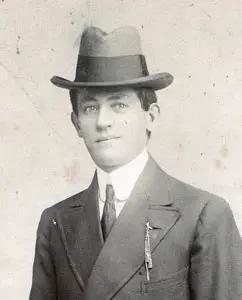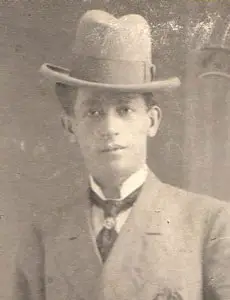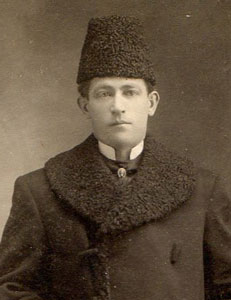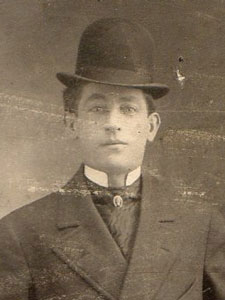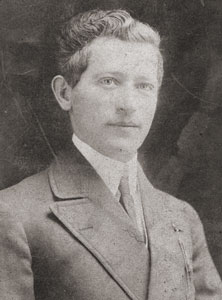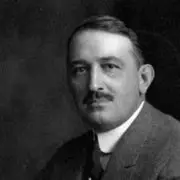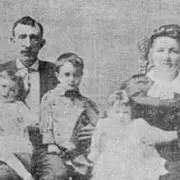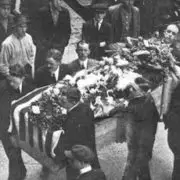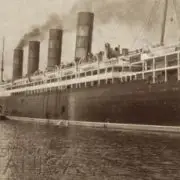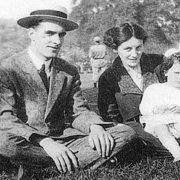The Lusitania : Part 7 : Passengers of Distinction
Dave Samuels was a singer and comic Yiddish monologist. He was born in Panciu, Romania, 1877-1880, as David Samoilovici. He gave birthdates of July, 1880, July 15, 1870, and June 19, 1879, on various passport applications.
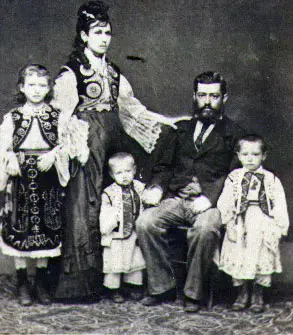
(Courtesy of Peter Berlanny)
He was the third child of six born to Berla and Anna Wasserman Samoilovici. His father was well to do, and ran a store which sold groceries, wine, hats, flour, and imported Parisian shoes. Berla’s granddaughter recalled him as a loving man, as he interacted with her, but also as a tyrant who was feared and respected by his wife and children. She told a story that revealed a softer side of Mr. Samoilovici, in which Berla returned home with a friend late on a winter night to discover an impromptu performance by his sons underway, with eldest son Haim, later known as Leon, playing the violin, youngest son, Jerome, playing the flute, and David singing and dancing. Berla’s eyes reportedly teared up as he watched, and he later asked his friend not to tell anyone about his display of emotion. Berla and his mother had fled Russia, on horseback, around 1848, when he was three years old. He would recall that his mother took him to Romania to avoid his being conscripted into mandatory military service. It is likely that anti-Semitism was a factor in their departure as well. The Samolovici’s beautiful home in Panciu was destroyed by an earthquake in 1940, as was the cemetery in which Berla and Anna were buried. The only surviving link to the family, by the 1970s, was a home for the indigent elderly Berla had endowed; an inscription on its façade still reading The Berla Sam House for the Aged. The structure existed as recently as 2004, but has been renamed and is now a tuberculosis hospital.
It is not clear how, when, or why David Samoilovici left his father’s prosperous and comfortable home. He was living in the heart of the Lower East Side of New York City by the time he was twenty. Virtually no biographical material regarding his teen years has come to light, and the few clues he left in his various passport applications and naturalization forms are contradictory, leaving the story of his journey from “beautiful” house to tenement untraceable.
David Samoilovici would later claim to have immigrated to the United States in November, 1894, from Liverpool, on an unnamed ship. He would also claim to have immigrated in 1901, aboard the Rhodesia, out of Liverpool. His November, 1914, passport gives an immigration date of December 10, 1899, aboard a ship named De Spacia out of London. A 1905 arrival aboard the Lucania showed David as a third class passenger and a recent resident of Manchester. He carried passports as David Samuels, David Samuelesco, and David Samoilesco, between 1909 and 1914. He was 5′ 6½”, with blue eyes, fair hair, a straight nose, and a tattoo on his right arm.
The earliest record of him in the United States is this citation found in the American Jewish Archives, in Cincinnati, Ohio:
Deafmute, or Buried Alive’]. Copied by David Samoilescu, Mar. 15, 1900,
New York. Ms. notebook. 111 pp. Neat hand. 8 1/2″ x 6 3/4″.
His marriage is easier to document. He and Lizzie Finkelstein were married, in New York City, some time between 1900 and 1903. Lizzie was also Romanian, born in Jassy in 1885. She was a singer before her marriage and continued working as one for a time afterward; perhaps performing with David. They first lived at 40 Delancey Street, but as David’s career improved they moved to the more upscale address of 227 St. Anne’s Avenue, the Bronx, NY, and, later, to 430 East 149th Street.
Their first child, Yetta, was born on August 20, 1903, Freida was born around 1904, their son, Julius, who later went by the name of Jerome, was born around 1906, and their youngest child, Hannah, was an infant in 1914.
The one constant in all of David’s papers was the date he became a United States Citizen. He was naturalized, as David Samoilesco, at the U.S. District Court in N.Y.C., on November 22, 1905. Lizzie did not apply, but was impressed with U.S. Citizenship by her husband’s naturalization. They were then living at 40 Delancey Street, on the Lower East Side. David listed actor as his occupation, and his father-in-law and agent, Adolph Finkelstein, of Orchard Street, served as his witness. He gave November 7, 1882 as his birth date, and June 19, 1897 as his date of arrival in the United States.
Virtually none of David’s alleged arrival dates can be verified through Ellis Island records.
Their U.S. citizenship was very important to David and Lizzie, and however vague he was with all of his other biographical details; his naturalization date was always pin-point accurate. A letter from Lizzie survives, requesting a duplicate copy of David’s naturalization certificate, which was lost with the Lusitania; she needed it as continuing proof of her impressed citizenship.
David relocated to London less than two years after becoming a U.S. citizen. He initially resided at 128 Whitechapel Road East, in London, and was represented by the Variety Artists Federation. Lizzie was with him, for a time; they applied for a joint passport in 1909 when they were “Traveling to Roumania to see my (David’s) mother, who is dangerously ill.” Their London address, as of 1910, was 52 Burton Road, S.W. They returned to the U.S. in 1912, aboard the Caronia, and it seems that Lizzie and the children remained in N.Y.C. thereafter.
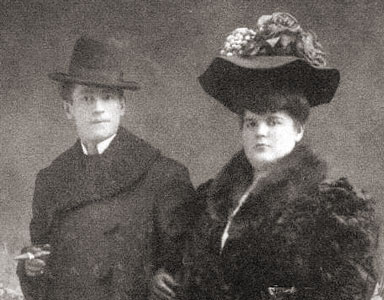
David and Lizzie
(Courtesy of Peter Berlanny)
Lizzie and her four children visited with David in London during the summer of 1914. They returned to the U.S. without him, aboard the Adriatic, in September, 1914. He joined his family in N.Y.C. in October, crossing aboard the Lusitania on her October 3rd sailing. He returned, alone, to his London address, at 18 Charing Cross Road, on the Lusitania’s December 5-11, 1914, voyage; the trip was made under heavy security after a bomb threat. He listed his profession as Music Hall Artist upon entering the U.K.
David returned to the United States for the final time on April 6, 1915, on board the Transylvania. The reason for his visit is not spelled out on his immigration form, but when he boarded the Lusitania on May 1, he was carrying with him a substantial sum of money, amounting to nearly five thousand dollars, as well as much of his personal jewelry. His cash and jewelry would be recovered, and shipped back to Lizzie aboard the Orduna in July.
David was one of the hundreds who died unnoticed, with no survivor later speaking of him in interview or letter. A brief mention of him, in a widely reprinted wire service story about the crowd gathered at the Cunard Line‘s London offices, might have raised Lizzie’s eyebrows had she read it:
Mrs. Cohan, an American woman, sat in the office through the night, waiting for news concerning Dave Samuels, vaudeville artist, who was engaged to a beautiful young girl who sat with Mrs. Cohan.
The brief mention was never followed up, and the truth of the account now cannot be determined. Perhaps it was a mistake, or perhaps the Samoilesco’s marriage had failed by 1915. Lizzie presented her marriage as happy, and rock-solid, in her subsequent claim against Germany and, save for this odd newspaper detail, there is no evidence to suggest that it truly wasn’t.
He was identified, as body #99, and buried, by the Jewish Burial Society, in Cork, Ireland.
The 1920 U.S. census found Lizzie and her children living in Brooklyn, NY. She was unemployed, and keeping a boarder at their residence.
Her claim against Germany, filed in the early 1920s, makes for very interesting reading. Mrs. Samoilesco estimated her husband’s overall worth at no more than $1000 in her original, 1916, claim against Germany. However, when Mrs. Samoilesco filed her second claim after the war had ended, her estimate had expanded a great deal. She claimed damages of $520,000.00, of which $20,000.00 was for lost personal property, including $15,000.00 in lost English gold currency.
She appended an additional claim of $10,050.00 for her own jewelry lost aboard the ship.
“Among her jewels…..was a platinum brooch set with diamonds ($3500.00) a platinum afternoon ring ($1500.00) a solitaire ring ($1000) a pair of earrings ($2500.00) and etcetera.”
The Mixed Claims Commission’s decision on this aspect of the Samoilesco case:
The Cunard Steamship Company returned to the widow personal property found on the body of the decedent, including all of his personal jewelry, some of which he was not wearing at the time of his death. If any inference may be drawn from this circumstance, it is that had the decedent taken with him the valuable jewels of his wife, whom he left behind in NY, they would have been found on his person with his own jewelry. There is no evidence that he deposited any valuables with the purser, and it is highly improbable that he would have placed in his baggage valuable(s) of small compass and weight…..although required to do so, claimant has failed to state from whom any one of these items was purchased or how she arrived at the stated valuations…..calls no one, not even her children, to corroborate her statement that she ever possessed them….or that the decedent took any of them with him…..
And the Samoilesco’s lifestyle? Lizzie testified that he earned upwards of $500.00 per week, of which $300 was allowed to her for personal expenses. She also claimed he sent the family on a $2000.00 two months vacation each summer. The Court ruled:
On his death we find his family living in a New York ‘apartment’ the rent for which, the widow testifies, was either $25 or $35 per month and it is fair to assume in absence to the contrary that their other expenditures were in proportion to the rental paid.
Here Lizzie may have been referring to the long visit she and her children had made to London in the summer of 1914, when she spoke of a $2000, two month vacation.
David’s personal effects?
Lizzie: ….there was lost with him a deluxe wardrobe, including a fur coat, lined with sable and trimmed with beaver collar and cuffs, which he had bought a short time before sailing and for which he had paid $3000.00.”
Court: She does not know from whom it was purchased, and produces no witnesses who ever saw the decedent in possession of such an article either on board the Lusitania or elsewhere.
The court allowed, however, that it could be reasonably expected that David was traveling with the conspicuously up-to-date style of wardrobe befitting a show business personality.
David’s lost gold?
The claimant testified….before the decedent left England for America he took from the safety deposit vault where he kept his valuables a large quantity of English Sovereigns and brought them to NY with him; that ‘he did not change any American money into British money- he brought the British money over here;’ that the decedent had on his person at the time of his death $4,729.00 in American paper currency which was subsequently returned by the Cunard Steamship Company; that this American currency was the proceeds of the English gold exchanged by the decedent on the claimant’s suggestion for American currency, but that the particular sovereigns claimed to have been lost were brought by the decedent from England to America and not exchanged for American currency, and he was taking them back with him. She claims that these 2,500 British gold sovereigns were in a little sack which, according to her best judgment she estimates as weighing three pounds…..the testimony of Lizzie Samoilescu is uncorroborated, conflicting and unconvincing…
The court ultimately awarded Lizzie Samoilesco: $25,000.00. A settlement of $25,000.00, to be divided, was paid to her children, and Lizzie was given a $2000 fee as administratrix of David’s estate.
Lizzie fades from the narrative after 1929. That summer found her mentioned in the newspapers because of a suit filed by her Lusitania claim lawyer. Mrs. Samoilesco felt that the percentage of the settlement money she had legally agreed to pay him was too high, and had declined to honor the agreement. The judge ruled against her and her adult children, but ruled in favor of a reduced percentage in the case of Hannah, Lizzie and David’s youngest child.
Lizzie Samuels lived with a man named Berkowitz, and had a son named Addie with him. She began going by the name of Lisa after she was widowed; a 1915 letter is signed as such, and that is the name by which her descendants know her. She died, of stomach cancer, during the war years. Yetta/Yvette Ellis can be traced further. Her Lusitania settlement money started her husband on the road to financial success. Abe Ellis was frequently in the newspapers, so certain pleasant aspects of Yetta’s life can be documented. She had children. She and Abe wintered in Florida. They owned Oscar Hammerstein’s former Manhattan Opera House, on West 34th Street in New York City.
The Ellis divorce, in the 1940s, was not amicable, and details about it found their way into the tabloids. Yetta apparently kept in contact with the family of David’s brother, Haim Samoilovici. Haim had changed his first name to Leon Berlanny, and relocated to London just after 1900. The Berlanny family has a photo of Yetta/Yvette, looking well-tailored, taken on a 1961 visit to England. Yvette Ellis gave her occupation as “dilettante” when she entered the U.K., aboard the Mauretania, in June, 1957. Family members remember her as a very elegant woman, a scholar of Greek and Latin who spoke with a refined voice, who would take her nieces and nephews to the theater in New York.
Yetta briefly followed in her father’s footsteps, and appeared on Broadway, in the play Rutherford and Son, in 1927.
David’s son Jerome also briefly headlined on Broadway, in the 1930 play The Challenge of Youth.
Jerome Samuelson did not get along with Lizzie’s common law husband, Al, and at the age of 13 he left home to live with relatives. He struck out on his own at age 16, leaving high school and moving into the Y.M.C.A. His settlement money from the Lusitania claim allowed him to survive. He met his wife, Goldie while working as a soda jerk. Relatives remember that he regretted leaving school, but that he continued to study on his own and was very knowledgeable about classical music. He and Goldie lived out their lives in Astoria, Queens.
Hannah Samuelson worked in a bakery. Her extended family remembers her as being a very nice person, but are unsure if shhe ever married or had children.
Archivist Catherine Gerbrands, at The Stage, provided us with an incomplete listing of his United Kingdom performances between 1908 and 1914. Gaps in the record might indicate periods in which he was performing on The Continent or in The United States. David was in Melbourne, Australia, in January 1912. A notice in the Melbourne papers announced that his popular engagement was coming to an end, and alluded to a prior long run in Sydney.
David’s act was almost always favorably reviewed. The focus of his performances seems to have been on comic parodies of popular songs, and comic “Hebrew monologues.” Several of the songs he parodied are named in reviews but, unfortunately, his “clever and amusing” rewrites were never quoted. His comic asides and stories were never quoted from, either, leaving the specific nature of his comedy unknowable.
Mr. J.L. Graydon’s “Lightning Programme,” which is enjoyed by full houses, has several scintillating features this week, a notable newcomer being Mr. Dave Samuels, who has been retained for a further week. Mr. Samuels, who is making his first appearance in England, is a Yiddish vocal and patter comedian, reaching England via America, and he musty be highly gratified by the reception meted to him by the local patrons, who have established him quite as a favourite. Mr. Samuels is distinctly versatile; he can sing- and sing well- tell some good stories, and dance as eccentrically as the best. His opening number is a mock-serious ditty, “I’m An Unlucky Jew,” after which he fires off some several funny stories, and includes in his first efforts a quaint parody on “Love Me and the World is Mine,” which Mr. Dave Carter is popularizing so much just now… Mr. Samuels should soon be busy on this side.
The Stage. October 17, 1907.
He was popular enough, in the final years of his career, to share a stage with Marie Lloyd, and to top the bill, repeatedly, at the London Palladium.
Dave Samuels’ Known Performances
February 6, 1908: Empire (probably in Middlesbrough); April 23, 1908: Regent Theatre (probably Salford.); May 7, 1908: The Pavilion, Glasgow; May 14, 1908: Belfast Hippodrome; May 28, 1908: King’s Theatre, Belfast ; June 4, 1908: Hull; July 16, 1908: The Empress, Brixton; November 5, 1908: The Balham Hippodrome; December 17, 1908: The Palace, Grimsby; March 17, 1910: The Willsden Hippodrome; April 7, 1910: Kilburn Empire; June 9, 1910: Top of the bill at Hull Hippodrome; July 7, 1910: Sheffield; August 11, 1910: King’s Theatre, Edinburgh; September 22, 1910: The Empire, Portsmouth; May 1, 1911: The Holborn Empire. George Robey is on the same bill; January 1912: Notice that David Samuels is finishing his popular engagement appears in Melbourne, Australia, newspapers; February 19, 1913: Hippodrome (possibly Warrington); April 3, 1913: David was one of the top billings at The London Palladium; May 8, 1913: Billed with Marie Lloyd and others at the Royal Hospital Gardens Chelsea on June 3 ; May 22, 1913: Booked by Jack Goodson Limited, for three tours of Moss Empires; May 14, 1914: David was again a top billing at the London Palladium. George Robey was also a top billing; July 23, 1914: Salford Regent; August 31, 1914: Salford Hippodrome; May 13, 1915: The Stage published a notice that David was not on the list of survivors on the Lusitania.

